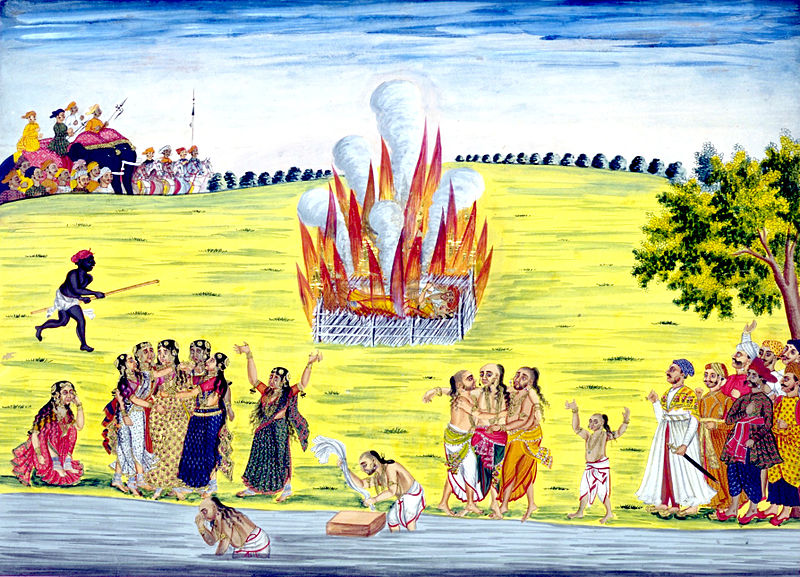Sati, also known as “Suttee,” was a tradition that was practiced in ancient India from the early centuries BCE to the mid-1990’s. In this tradition, widows were burned at the side of their deceased husbands. There were many reasons behind this tragic form of suicide, but the act was seen as heroic and courageous. The tradition originates with the goddess Sati, who burned herself to death in a fire that she created through her yogic powers, which she obtained after her father had insulted her husband. Sati became an option for women in India who were not “marriageable,” according to social norms. Sati was first recognized in the Mahabharata, one of the two most well-known and important poems of India.1
“LAMP of my life, the lips of Death
Hath blown thee out with their sudden breath;
Naught shall revive thy vanished spark . . .
Love, must I dwell in the living dark?” -Suttee by Sarojini Naidu2
The practice of Sati is recounted by a first century BCE Greek author named Diodorus Siculus. Diodorus mentioned sati stones, which were memorials of all of the wives that have passed along with their husbands. A stone was created for each wife after she gave up her life, and these stones were all collected into a shrine. The earliest memorial that has been discovered dates from 510 BCE.3

Another practice that branched out from sati was the Jahuar, which was a sacrifice of any Muslim woman from the twelfth through the sixteenth century. It was believed that if a woman was burned, she would be safe from rape, which was worse than dying at the hands of a conquering enemy.4
Sati was also practiced by the Brahmans of Bengal, by the system of law from 1100 CE, which was called Dayabhaga. If a woman was widowed, her inheritance would be given to the children of her passed husband. If she were to remarry, her inheritance from her deceased husband would be given to the children and her new husband and her other children would not receive anything. If she passed along with her husband, the inheritance would be given to the children of her dead husband. This law was ended by the Mughal rulers Akbar and his father Humayun in the sixteenth century.5
In 1829, when India was informally ruled by Great Britain, the law to make sati illegal was passed because the act was seen by the British as harsh and cruel to women. Although it was made illegal, there were controversies over whether the sati practice was a religious act, and if so, should that be taken into consideration before prohibiting it.2
In 1987, Roop Kanwar, a woman from the village of Deorala in Rajasthan India, was married to her husband for only eight months before he died. She decided against taking her life in front of thousands of people. Politicians and activists believed that Roop Kanwar was then subsequently drugged by the liquid inside the seeds of an opium poppy flower, and pressured to take her life by those around her. Some people even say that she had super natural powers because her eyes were glowing bright red as she burst into flames. Police concluded that a group of men had been guilty of having drugged her, and they were placed under arrest.7
Sati was a rather harsh tradition, but the significance of these rituals was important to many Indian traditions. The thought of self sacrifice in this way is foreign to Western traditions, and the thought of being burned alive is worse. Sati is now illegal and no longer practiced, but the memories of the dead women from this tradition remain and they will always remind us of this social practice.8
- Kashgar, 2009, s.v. “Life in India: the practice of sati or widow burning,” by Linda Heaphy. ↵
- The Denson Journal of Religion, April 2015, s.v. “Interpreting Sati: the Complex Relationship Between Gender and Power in India,” by Cheyenne Cierpial. ↵
- Dorothy Stein, Burning Widows (University of British Columbia: Pacific Affairs, 1988), 466. ↵
- The Denson Journal of Religion, April 2015, s.v. “Interpreting Sati: the complex Relationship Between gender and Power in India,” by Cheyenne Cierpial. ↵
- Encyclopedia Britannica, March 2015, s.v. “Suttee,” by Wendy Dongiger. ↵
- The Denson Journal of Religion, April 2015, s.v. “Interpreting Sati: the Complex Relationship Between Gender and Power in India,” by Cheyenne Cierpial. ↵
- Encyclopedia Britannica March 2015, s.v. “Suttee,” by Wendy Dongiger. ↵
- Sophia Gilmartin, “The Sati, the Bride and the Widow: Sacrificial Woman in the nineteenth century,” Victorian Literature Vol. 25, No.1 (1997): 142. ↵



99 comments
Thomas Fraire
This article was cool, the traditions are wild though Sati had her followers go through some crazy things. I really wish they would’ve been more specific instead of summarizing the events. There were like things that could’ve been expanded on I felt like at times it felt like I was reading an encyclopedia. But it would fluctuate between this artificial feel to personal, maybe If it was expanded a little more it would’ve been really good.
Sarah Mares
Sati was definitely interesting to read and learn about. I do agree that it is a rather harsh tradition, but in a way, I think it is oddly romantic and also super crazy. It sounds only partially O.K. because the widow will essentially get to be with their significant other forever, ebbed as they pass on. This social practice is very unique yet very deadly and solemn. Despite how often and long it was practiced for, I’m glad it was discontinued as an Indian tradition.
Andrew Rodriguez
Wow this article was very shocking. The will and true love of women, who would do this is a true form of love. Or in some cases an act of tradition, I can see why this was view as cruel and unconventional. Was not by choice, but by force as I can tell in the article towards the end. As the brave women denied to kill herself, this showed the power and meaning of the ideology. By the elderly and everyone else around her forced her to kill herself. The cultural showed that the woman were useless without the man, useless to society.
Alejandra Mendez
I’ve heard of practices like these before but had never looked into them nor knew the name they went by. Just as the article states, I too find them somewhat cruel towards women. However, I find the meaning much more valuable. This was seen as honorable at the time and I can see why as well. No woman was ever forced, with the exception of Roop Kanwar who was seemingly under the influence of drugs, because they found the value in it themselves. Very interesting article and choice of topic. It’s definitely a very informative piece.
Samman Tyata
I really like the way how you have managed the article. Well, I had some knowledge about “Sati” previously but after going through the article I got to know about Sati stones, which is something new for me. It is upsetting that this was a tradition that was carried out and practiced for which the innocent women lost their life for no any reason. The article shows that each culture has its own way of doing things which have certain significance. To conclude, I was a good read.
Matthew Rios
As I read about such traditions, I’m thankful such savage modes of conduct have for the most part left civilization. Our world still sees things like this though that are comparable, and at the risk of being ethnocentric, those types of practices and others that are still done today are just savage in nature compared to the civilized man and woman. Although a world without savagery is wishful thinking right now. A dim topic, but very educational piece. Holding in any form of bias with writing is difficult, but you did it well !
Sergio Cervantes
How awful it must have been to see these women burned alive next to their deceased husbands! I find it somewhat disturbing that such a practice existed but yet intrigued that humans did this. It shows how dedicated these women were to their husbands and proved the love that they had for them. I like that you included a picture of the multiple stones dedicated to each women who gave her life in accordance with the ritual of Sati.
Nicolas McKay
This was certainly a very interesting article. Sati is certainly one of the harsher traditions of ancient times. I feel like women were pushed, or even forced such as in the case of Roop Kanwar, to practice ritual suicide. It is unfortunate that for amny women this was their best option. You did a great job exploring the history of sati, all the way back as far as you did.
Mario De Leon
This is a very interesting article on a practice that seems bizarre but was looked at as heroic and courageous. I liked the featured image that your choice to use I really didn’t examine it until after I was done reading your article but it is powerful. It’s hard to believe if a practice like this was still in affect but it shows how strong tradition can be for some cultures.
Ana Gonzalez
I’m glad this article was nominated for an award in “Culture”. You chose a very interesting article and one that is very radical. The tradition of Sati, was in my opinion, cruel and unnecessary. Women should not have to end their life simply because a man is no longer with them. I’m glad this has ended, and that you wrote an article that shines light on the issue.
Great job! Thank you, hope you win an award.